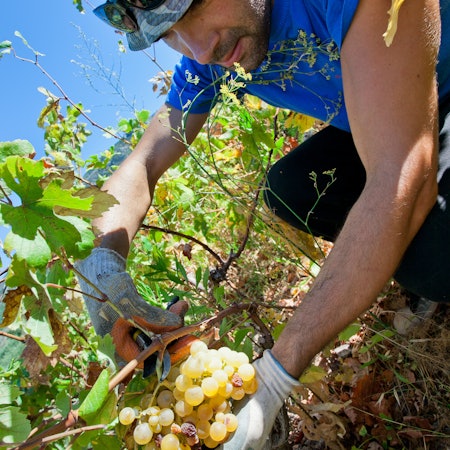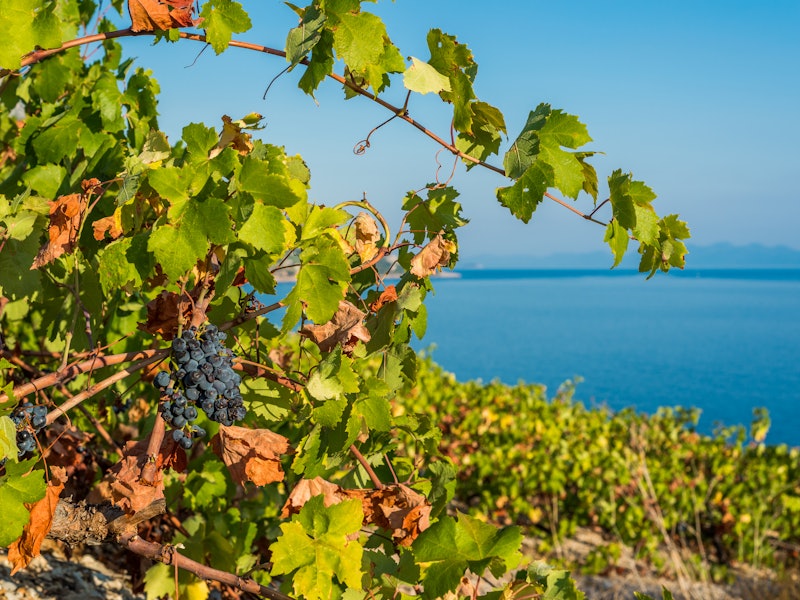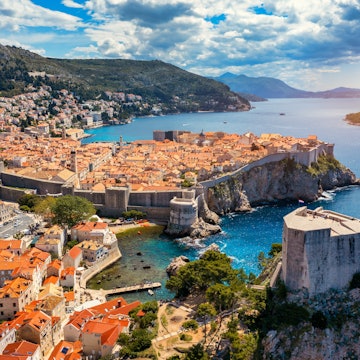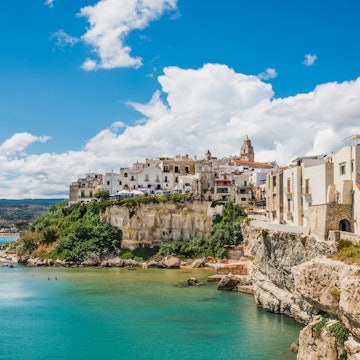

Vineyards outside Motovun in Istria. Daniel Alford/Lonely Planet
While many travelers head to Croatia dreaming of itineraries that prize sun, beaches and that signature Adriatic sparkle, outstanding wine is an unexpected add-on. This insider secret transforms a trip deliciously, sip after sip after sip. Enjoying a glass of world-class wine in a stone-walled cellar or watching the sunset over golden hills from a vineyard terrace is about more than just taste; it’s a doorway into Croatia’s culture, character and long-standing traditions.
Many of the wine regions don’t show up on mainstream lists of what to see and do in Croatia. Largely off the radar, they come with their own set of rules, so we are pairing this guide with tips to help you have the most delightful wine experiences across the country.

What is the history of Croatian wine?
Long before towns were established and roads traversed Croatia, ancient Greeks called Dalmatia’s Vis Island the Land of Wine and set out rows of vines that still bask in the sun today. On Hvar Island, paths crisscross the pretty fields on the UNESCO-protected Stari Grad Plain, the same land that’s been farmed for 2400 years, its original dry-stone walls guarding secrets passed down over generations. Every wine you try here packs in a sense of living history.
The ancient Romans prized these hills too. They made amphorae and cellars that still lie underground beneath Croatian towns, where the smell of stone and sea air lingers long after the wine’s been poured. The history of wine spans centuries in Croatia, and every winemaker seems eager to share how their family defied wars, disease and weather to coax out the next harvest.


What are Croatia’s main wine regions?
Croatia has more than 300 micro wine regions and at least 130 indigenous grape varieties. These micro regions fall into a few main areas.
The northwestern coastal region of Istria and Kvarner is known for its crisp Istarska malvazija whites and earthy teran reds. The Mediterranean climate across the rolling hills and medieval hilltop towns is perfect for pairing local wine with the fresh seafood and truffles that define the region’s flavors.
Extending along Croatia’s sun-soaked coast and islands to the south, Dalmatia is home to plavac mali reds (a relative of zinfandel) and salty whites like pošip and grk. This region’s highlights include terraced island vineyards, dramatic sea views and wine-making traditions rooted in centuries-old villages.
The northeastern plains of Slavonia and Baranja produce celebrated whites, especially graševina, as well as aromatic traminer and frankovka reds. Slavonia is known for grand old wineries, barrel-aging traditions and fertile land that produces full-bodied, food-friendly wines.
The regions of continental Croatia (the uplands) around Zagreb – in Plešivica, Zagorje, Međimurje and Moslavina – excel in sparkling wines, sauvignon blanc, pušipel and rare grapes like škrlet and portugizac. In these pastoral farmlands, you’ll find pretty family estates, innovative producers and a focus on varietal diversity.

What do I need to know before I go?
Traveling Croatia’s wine roads is relaxed and easy. Aside from a few famed wineries, most are small and family run, and they often don’t have clear signs. It’s a good idea to call ahead to make sure someone is available for tastings.
It’s not uncommon to shake hands with the winemaker or share a table with locals, which makes the visits personal and spontaneous. Bring an open mind, respect the slower pace, and don’t be shy to ask questions – winemakers here love to talk shop – but they’ll appreciate basic courtesy: take only small sips, and swirl, sniff and savor, rather than knocking back each pour.

What do I need to bring?
Traveling the wine roads of Croatia is simple, but a bit of planning helps. Bring cash, especially if you’re heading off the beaten path, since not every winery will take credit cards. Vineyards are often beautifully remote (winding roads with dazzling sea views or forested slopes). Pick a designated driver, arrange a taxi, or book a small group tour – relaxing is half the joy of tasting wine.
Throw in a little curiosity to your conversation and look up the main grapes before visiting a wine region. Ask about teran, plavac mali or pošip and tastings will sparkle even more. Packing layers is a good idea, as cellars can be chilly even in summer, so be sure to have a sweater and a hat for vineyard strolls. If you want to walk away with notes, bring a notebook or a wine app, as memory can get fuzzy after three samples.


Tips for touring wineries in Croatia
If you want to blend in, be open to slow, spontaneous moments and let the experience unfold naturally. Sometimes this means enjoying farmhouse cheese, slices of pršut (prosciutto) or homemade bread with a vineyard view. Tastings are meant to be savored, so take your time.
If your host, many of whom double as vineyard stewards, storytellers and pourers, offers to show you around, always say yes to the vineyard walk or cellar tour.
While some charge a flat fee for tastings, many of the wineries will let you taste the wines for free, with the expectation that you’ll buy at least a bottle. Bringing back your favorites extends a fabulous memory (and a great story) to your table at home.

Best places to taste wine in Croatia
Croatian wine changes a lot from region to region. Try what’s local, whether it’s malvazija in Istria, plavac mali on the Pelješac peninsula or a crisp graševina in Slavonia. Finding a new favorite is part of the fun, but there are some well-known wineries to keep in mind as you explore.
In Istria, the stone tasting room at Kozlović, the wine hotel hideaway Roxanich near Motovun, the amphora-loving Kabola near Momjan and Vina Radovan are some of the standouts. In Kvarner, seek out the intimate tastings at Ivan Katunar on Krk Island, sampling žlahtina, the local white, on a sunny terrace.
In Dalmatia, Saints Hills on the Pelješac peninsula stirs awe with vineyard views and legendary reds like plavac mali; Bibich in Skradin is famed for bold experimentation and the dry red bibić, an indigenous variety; while Zlatan Otok on the southern shores of Hvar Island does underwater wine tastings.
To the east, in the off-the-radar region of Slavonia, step into the cool, echoing cellars at Kutjevo, explore the gentle hills of Erdut and its winery, see Baranja's gatori (traditional wine cellars dug into hillsides) – Josić is the most renowned and has an upscale restaurant – or go as east as Ilok, where you should ask for a glass of traminac at Iločki Podrumi.
Just outside Zagreb, in the upland wine country of Plešivica, known as Croatia’s Champagne, over 40 wineries are known for sparkling wines. The most recognized is Korak, which also has a Michelin-starred restaurant on its estate, but there are smaller players worth visiting, too, like Šember and Lagradi.
Looking to tie it all together? Local outfits like Croatia by the Glass, Hvar Tours and D’Vino do the heavy lifting, from winery access to transport, freeing everyone up for that second (or fourth) glass without worry.

When to go to Croatia's wine regions
The best times to visit Croatia for wine lovers are spring and fall, when the country’s vineyards are alive with energy and the calendar is rich with rituals. Late September into October ushers in the grape harvest (berba), with hands-on experiences and festivals that cackle with good energy. The annual St Martin’s Day celebrations on November 11 transform entire towns and villages into joyful, wine-soaked gatherings complete with tastings, feasts and live music.
Spring, especially May and early June, offers temperate weather perfect for vineyard walks and uncrowded cellars, while summer holds lively local events, though it gets busy with holidaymakers. Offseason visits can mean cozy, fireside tastings with plenty of attention from the winemaker.
So set out and follow Croatia’s winding roads. Ask questions, enjoy each sip while sitting on sun-warmed terraces as dusk arrives, and raise your glass to toast with a hearty “živjeli!”
















